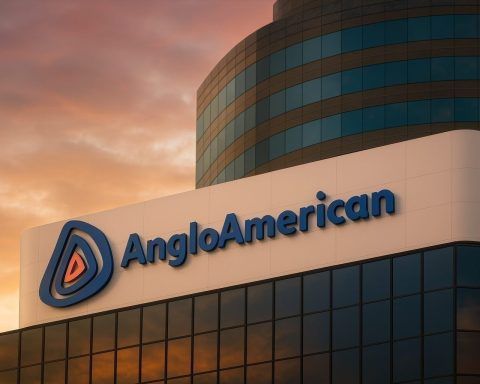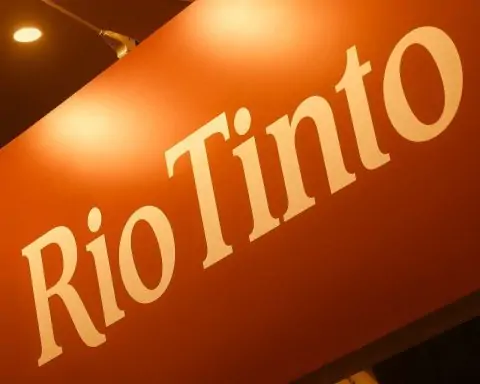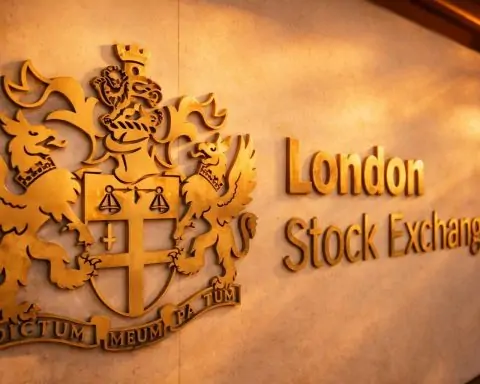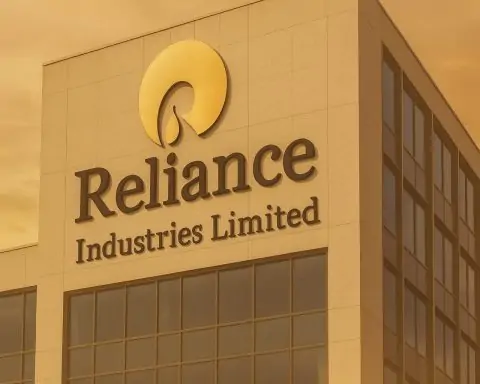Applied Materials (NASDAQ: AMAT) beat fiscal Q4 2025 earnings expectations, but AMAT stock fell around 5–7% on November 14 as U.S. export controls and weaker China spending weighed on the 2026 outlook.
Key takeaways
- Q4 beat, FY record: Applied Materials reported fiscal Q4 2025 revenue of $6.8 billion, down 3% year over year but ahead of Wall Street estimates, with non‑GAAP EPS of $2.17 also topping consensus. Full‑year revenue hit a record $28.37 billion, up 4%. [1]
- Margins and earnings: GAAP diluted EPS rose to $2.38 in Q4 (up 14% YoY), while full‑year non‑GAAP EPS climbed to $9.42, up 9% from fiscal 2024. [2]
- China drag in 2026: Management expects wafer fab equipment (WFE) spending in China to decline in 2026 and estimates a roughly $600 million revenue hit from expanded U.S. export controls, after about $110 million of Q4 orders were delayed under an “affiliate rule.” [3]
- Stock reaction: AMAT shares traded roughly 5–7% lower on November 14 in premarket and early U.S. trading, making the stock one of the notable decliners in a broader tech sell‑off, even though it remains up about mid‑30% year to date. [4]
- Analysts still bullish: Evercore ISI lifted its price target to $290 (from $208), Cantor Fitzgerald reiterated an Overweight with a $300 target, while Fubon Securities upgraded AMAT to Buy with a $260 target. TipRanks data shows a “Moderate Buy” rating with an average target around $219 (pre‑earnings). [5]
Q4 2025: Earnings beat and record year, but slower growth
Applied Materials, the world’s largest semiconductor equipment maker, reported fiscal Q4 2025 results for the quarter ended October 26, 2025, on Thursday evening, followed by a sharp market reaction on Friday, November 14. [6]
Revenue and profit
According to the company’s earnings release:
- Q4 revenue: $6.80 billion, down about 3% from $7.05 billion a year earlier, but ahead of analyst expectations around $6.67–$6.68 billion. [7]
- Q4 GAAP net income: $1.90 billion, up from $1.73 billion (+~10% YoY), thanks in part to higher margins and investment gains. [8]
- Q4 GAAP diluted EPS: $2.38 vs. $2.09 a year earlier, up about 14%. [9]
- Q4 non‑GAAP diluted EPS: $2.17 vs. $2.32 last year, still comfortably ahead of the ~$2.11 Street consensus. [10]
For the full fiscal year 2025:
- Revenue: $28.37 billion, up 4% from $27.18 billion in fiscal 2024 — a new company record. [11]
- GAAP diluted EPS: $8.66, up 1% year over year.
- Non‑GAAP diluted EPS: $9.42, up 9% versus $8.65 in fiscal 2024. [12]
In other words, top‑line growth slowed, but profitability improved, reflecting stronger pricing, mix and cost discipline, even as export controls and restructuring weighed on operations.
Segment performance
TipRanks’ breakdown of the quarter shows the following segment revenues: [13]
- Semiconductor Systems: ~$4.76 billion
- Applied Global Services: ~$1.63 billion
- Display and Adjacent Markets: ~$355 million
- Other: ~$60 million
Core semiconductor tools and services both saw year‑over‑year declines, while display and “other” categories grew, highlighting how memory and AI‑related investments are partly offsetting softer spending in other chip categories. [14]
Geographic mix: China still big, but shrinking
The company’s own data show that China remains Applied Materials’ single largest market but with a lower share than in prior years: [15]
- Q4 2025: China generated 29% of revenue, down from 30% a year earlier.
- Full year 2025: China accounted for 30% of revenue, down sharply from 37% in fiscal 2024.
That shift is important for understanding why export controls now matter so much to the stock.
2026 outlook: export controls vs. AI boom
The central narrative for November 14 is not the Q4 beat, but what comes next.
Guidance for fiscal Q1 2026
For its fiscal first quarter (running through January 2026), Applied Materials guided to: [16]
- Revenue: $6.85 billion, plus or minus $500 million
- Consensus before the call: roughly $6.76–$6.80 billion
- Still implies a 4%+ year‑over‑year decline, as last year’s first‑quarter sales were higher. [17]
- Adjusted EPS: about $2.18 ±$0.20, versus expectations around $2.15. [18]
So, guidance is slightly ahead of Wall Street forecasts, but not enough to overcome concerns about a near‑term downcycle in wafer fab equipment.
The China export‑control hit
Across multiple outlets and management commentary, a consistent picture has emerged: [19]
- Export rules delayed shipments: Around $110 million of Q4 revenue couldn’t be shipped because of U.S. rules governing sales via affiliates; that rule has since been suspended following talks between U.S. President Donald Trump and Chinese President Xi Jinping, and those tools are now expected to ship in Q1.
- Bigger impact in fiscal 2026: Expanded U.S. export controls on advanced chip equipment to China are expected to reduce fiscal 2026 revenue by about $600 million, according to recent company disclosures and analyst summaries.
- Weaker China spending: Management and news coverage repeatedly highlight that wafer fab equipment spending in China will be lower in 2026, as local chipmakers scale back or delay certain investments under the tighter rules.
Reuters and other outlets framed Applied Materials as the first major chip‑tool vendor to quantify a 2026 China slowdown, even as peers like ASML and KLA have echoed similar concerns. [20]
AI and memory as the offset
Despite the near‑term headwinds, the company and several analysts remain constructive on the second half of 2026: [21]
- Applied expects demand to improve in the second half of calendar 2026, driven by AI‑related spending and a recovery in certain memory markets.
- AI training and inference workloads are pushing hyperscale cloud providers and leading chipmakers to invest heavily in advanced nodes, high‑bandwidth memory (HBM) and packaging, all areas where Applied supplies critical process tools.
- Several commentaries describe 2025–early 2026 as a “pause” in China rather than a structural collapse in global demand, with stronger orders anticipated from Korea, Taiwan and U.S. fabs as AI projects ramp. [22]
In short, the China headline is negative, but the AI story remains a powerful tailwind further out.
How AMAT stock traded on November 14, 2025
On Friday, AMAT was one of the most watched names on Wall Street.
- Trading data from multiple sources indicates that shares were down roughly 5–7% in pre‑market and early cash trading after the earnings release and China commentary. [23]
- Benzinga’s pre‑market movers list showed AMAT around $213.10, down about 7.6%, while other outlets cited drops in the 4–6% range. [24]
- Year to date, the stock is still up roughly mid‑30%, lagging some peers like Lam Research and KLA but significantly outperforming the broader market. [25]
The sell‑off came against the backdrop of a wider tech correction: Nasdaq and S&P futures were in the red, and major indexes had already dropped sharply the day before. Investopedia’s live market coverage specifically flagged Applied Materials as one of the notable decliners after CEO Gary Dickerson warned that China WFE spending would be lower in 2026. [26]
Wall Street reaction: price targets rise despite the drop
While traders focused on the near‑term hit from export controls, Wall Street analysts largely stuck with a positive long‑term view.
Fresh price targets and ratings
Recent notes highlighted on November 14 include: [27]
- Evercore ISI: Raised its price target to $290 from $208 while maintaining an Outperform rating, citing Applied’s leverage to AI and advanced packaging despite export‑control uncertainty.
- Cantor Fitzgerald: Reiterated its Overweight rating with a $300 price target, arguing the stock looks undervalued versus InvestingPro’s fair‑value estimates at a recent price around $223.
- Fubon Securities: Upgraded AMAT from Neutral to Buy, lifting its target to $260 from $190, reflecting confidence that the company can manage through the China reset.
- TipRanks consensus: Before incorporating the latest earnings, TipRanks showed a “Moderate Buy” consensus based on 17 Buy, 9 Hold and 1 Sell ratings, with an average price target near $218.78 per share.
At the same time, some research pieces describe Q4 as a “mixed” print: EPS and margins beat expectations, but revenue growth slowed and non‑GAAP EPS declined year over year, which is typical for a late‑cycle downshift in chip‑equipment spending. [28]
Institutional flows: hedge funds and asset managers edge in
Beyond analyst commentary, institutional ownership continues to rise, which is relevant for longer‑term investors watching “smart money” moves.
- A MarketBeat report on November 14 notes that Fiera Capital Corp increased its position in Applied Materials by 17.4% in Q2, bringing its holdings to 49,529 shares worth roughly $9.1 million at the time of the filing. [29]
- The same filing roundup lists several smaller investors adding AMAT exposure and estimates that institutional investors now own over 80% of the float. [30]
- A separate 13F‑focused article highlighted that Bridgewater Associates, the hedge fund founded by Ray Dalio, initiated a new position in Applied Materials among its notable Q3 trades, while trimming some Nvidia exposure. [31]
These moves suggest that large, fundamentally driven investors are willing to look through the near‑term volatility, even as short‑term traders react sharply to China‑related headlines.
Key financial and strategic metrics at a glance
From the Q4 and FY 2025 reports and subsequent analysis, several numbers stand out: [32]
Fiscal Q4 2025 (quarter ended Oct. 26, 2025)
- Revenue: $6.8B (–3% YoY), beating estimates around $6.68B
- GAAP gross margin: 48.0%
- GAAP operating margin: 25.2%
- GAAP diluted EPS: $2.38 (+14% YoY)
- Non‑GAAP diluted EPS: $2.17 (vs. $2.32 a year ago)
- Net income: $1.90B (+~10% YoY)
- Free cash flow (non‑GAAP): $2.04B
Fiscal year 2025
- Revenue: $28.37B (+4% YoY, record high)
- GAAP diluted EPS: $8.66 (+1% YoY)
- Non‑GAAP diluted EPS: $9.42 (+9% YoY)
- Non‑GAAP operating margin: 30.2%
- Cash & equivalents: $7.31B at year‑end
Geography (Q4 2025)
- China: $1.96B (29% of revenue), down from 30% the prior year
- Taiwan: $1.83B (27%)
- Korea: $1.22B (18%)
Guidance (Fiscal Q1 2026)
- Revenue: $6.85B ±$0.5B
- Adjusted EPS: $2.18 ±$0.20
- Expected decline in China WFE spending and estimated $600M revenue headwind in fiscal 2026 from export curbs
What this means for AMAT investors and the chip cycle
For investors following Applied Materials and the broader semiconductor equipment space, November 14’s news flow underscores three big themes:
- Near‑term earnings remain resilient.
Even in a soft patch for wafers and logic, Applied is delivering better‑than‑expected EPS, record annual revenue and strong cash generation, giving it room to keep investing in R&D, share buybacks and dividends. [33] - Geopolitics, not demand, is the main swing factor.
The most significant negative driver in the story is policy‑driven: export controls and licensing rules that change how much it can ship to China and when. Underlying demand for advanced nodes, memory and AI infrastructure is still expected to grow into 2026 and beyond, particularly outside China. [34] - Analysts and institutions are still leaning long‑term positive.
Price‑target hikes from Evercore and Cantor, Fubon’s upgrade, plus increased stakes from firms like Fiera and Bridgewater, all point to a view that the recent pullback is more about timing and geopolitics than a broken business model. [35]
For anyone considering AMAT, the key questions over the next 12–18 months will be:
- How quickly do non‑China customers (in Korea, Taiwan, the U.S. and Europe) ramp orders for AI‑related capacity?
- Do export rules stabilize, allowing Applied to plan shipments more predictably?
- Can the company sustain 30%+ non‑GAAP operating margins if revenue growth stays low or negative for several quarters? [36]
As always, this article is for informational purposes only and does not constitute investment advice. Anyone interested in AMAT stock should consider their own risk tolerance, time horizon and professional financial guidance.
References
1. www.globenewswire.com, 2. www.globenewswire.com, 3. www.tradingview.com, 4. www.tradingview.com, 5. m.investing.com, 6. www.globenewswire.com, 7. www.globenewswire.com, 8. www.globenewswire.com, 9. www.globenewswire.com, 10. www.globenewswire.com, 11. www.globenewswire.com, 12. www.globenewswire.com, 13. www.tipranks.com, 14. www.tipranks.com, 15. www.globenewswire.com, 16. www.tradingview.com, 17. theedgemalaysia.com, 18. www.tradingview.com, 19. www.tradingview.com, 20. www.reuters.com, 21. theedgemalaysia.com, 22. www.globenewswire.com, 23. www.tradingview.com, 24. www.benzinga.com, 25. theedgemalaysia.com, 26. www.investopedia.com, 27. m.investing.com, 28. www.tipranks.com, 29. www.marketbeat.com, 30. www.marketbeat.com, 31. seekingalpha.com, 32. www.globenewswire.com, 33. www.globenewswire.com, 34. coincentral.com, 35. m.investing.com, 36. www.globenewswire.com










